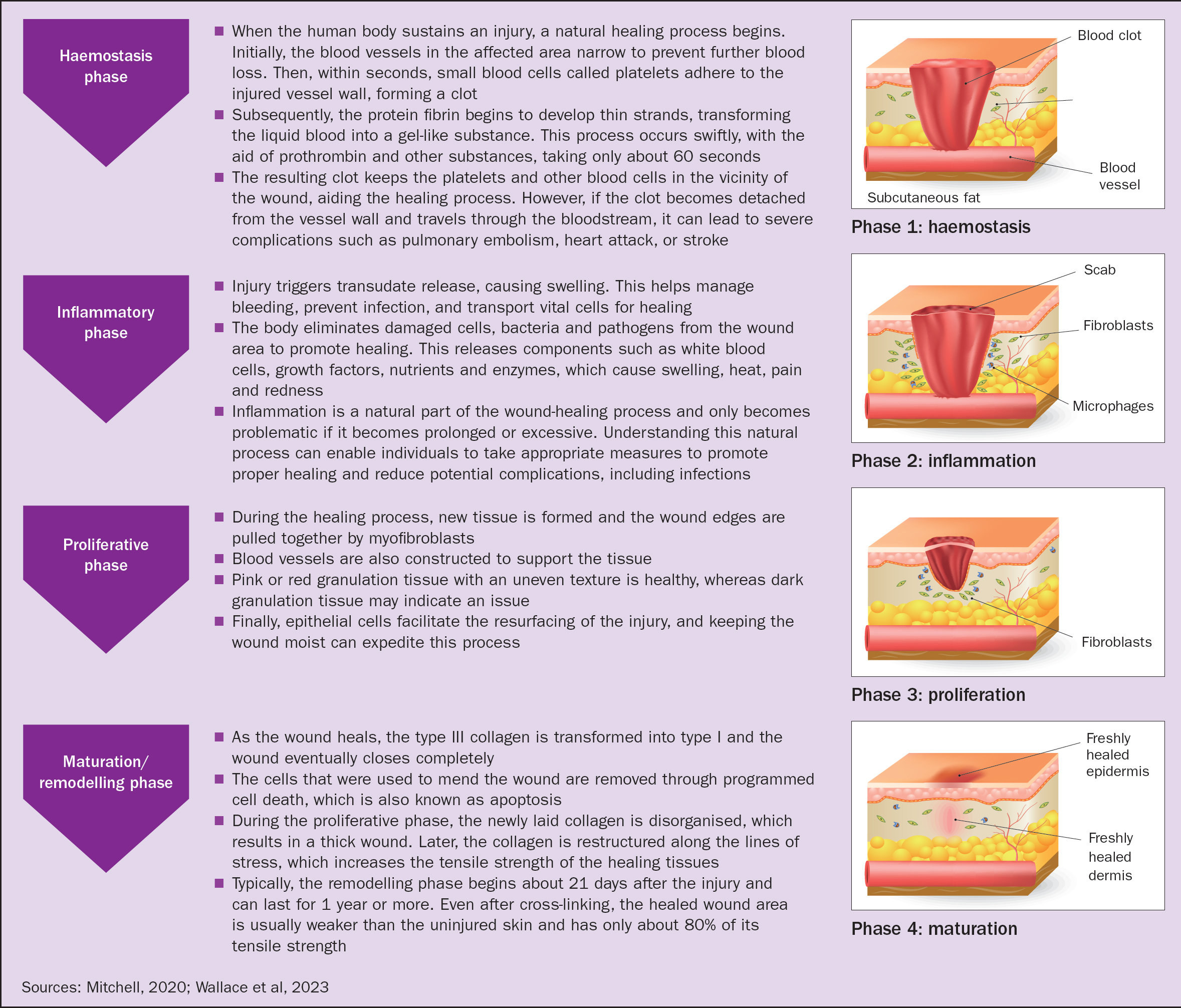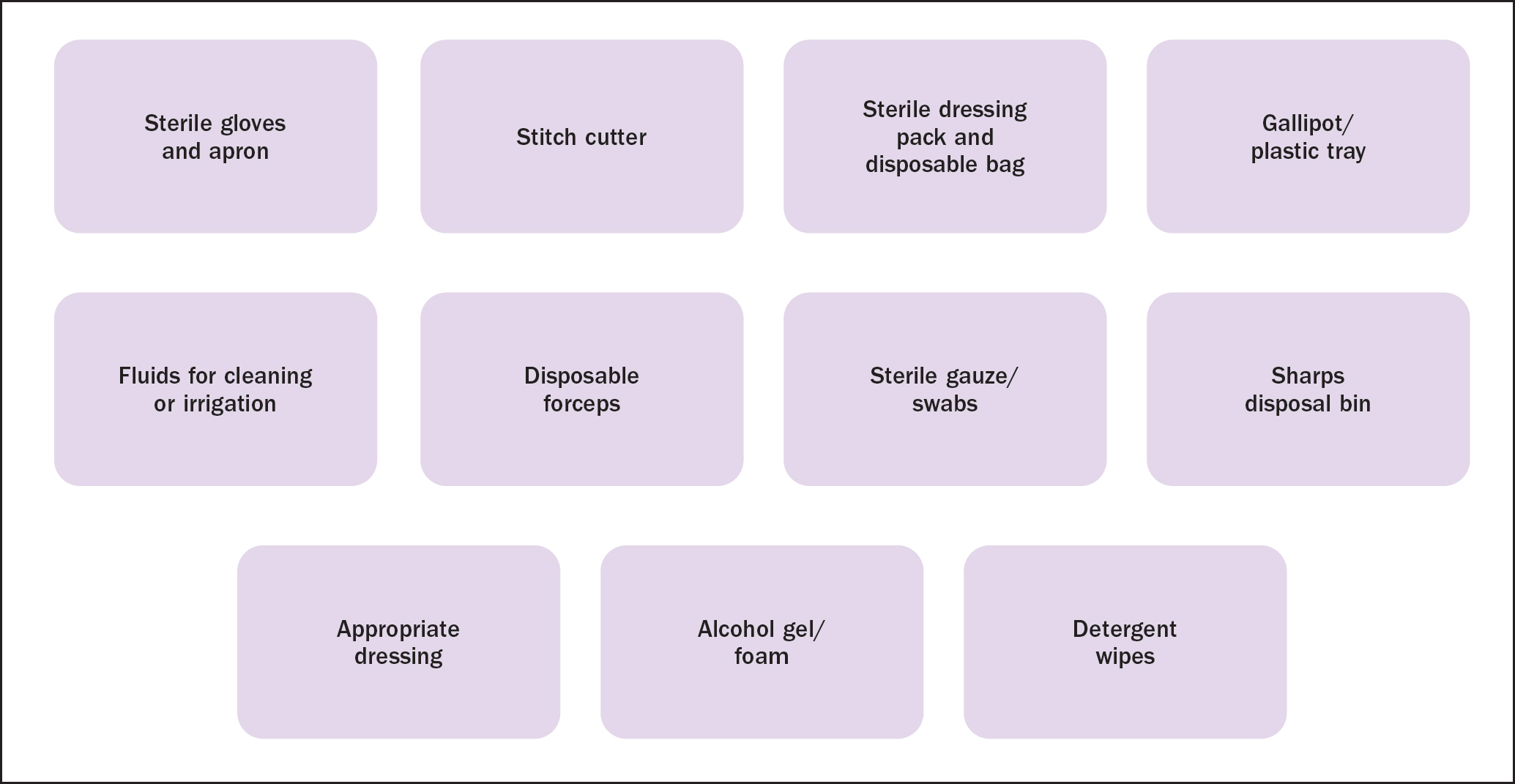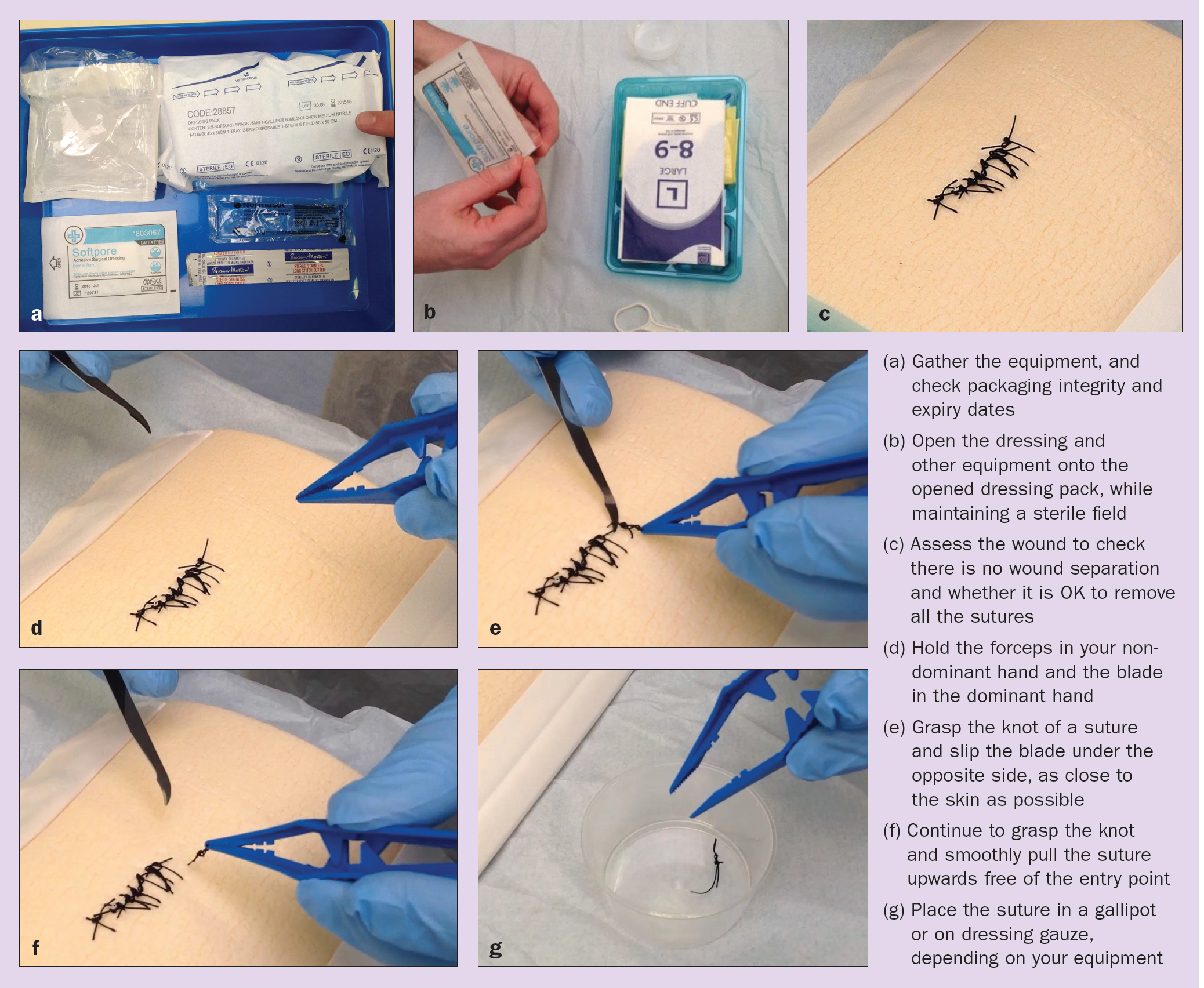Wound healing is the process by which the body replaces and restores damaged tissue (Greaves et al, 2013) and enhanced mechanisms such as regeneration and tissue repair are initiated to help the healing process. It is a normal biological process that follows precisely programmed and highly regulated phases (Wallace et al, 2023). In general, wound healing is described as having four distinct phases: homeostasis, the defensive and inflammatory phase, the proliferative phase, and finally the maturation phase. These phases are collectively referred to as the healing cascade and work together to promote the healing of wounds (Figure 1). For a wound to heal effectively all four phases must occur in the proper sequence and time frame (Coloplast, 2023). However, as the healing process involves a complex interaction of physical, chemical and cellular events, a multitude of factors can interfere with one or more phases of the process, leading to improper or impaired wound healing.

Tissue regeneration
The body is capable of regenerating certain types of cells, such as epithelial cells, and this is considered to be the most effective method of healing because the regenerated tissue retains the same functionality and appearance as previous tissue.
Tissue repair
This is a complex process that can result in visible alterations to the repaired area as the body repairs damaged or destroyed dermal or subcutaneous tissue. Consequently, during this process, the repaired tissue loses its specialised function and original structure, leading to scarring and changes in the skin's appearance.
Primary, secondary and tertiary intentions
It has been identified that there are three ways that wounds heal: primary intention, secondary intention, and tertiary intention, depending on the wound type and cause. Cook et al (2020) suggest that the healing process is essentially the same in each, although the times scales may differ.
Primary intention
Surgical incisions with minimal tissue loss can heal quickly through primary intention with the use of sutures, staples, or clips (Curr and Fordham-Clarke, 2022). This type of healing is uncomplicated, with minimal scarring and no tissue deficit; however, the time to heal will depend on a patient's overall health status. The initial union of wound edges takes 7–10 days and the maturation stage can take up to 2 years.
Secondary intention
When there is tissue loss, wounds heal through a process described as secondary intention, which involves granulation and epithelialisation. The body produces granulation tissue to fill in the tissue deficit before forming scar tissue. The healing time frame is usually significantly longer than through healing by primary intention.
Tertiary/third or delayed intention
This involves intentionally keeping a wound open to allow for swelling or infection to resolve. It is a form of delayed primary intention: it will result in more scarring than when a wound heals by primary intention, but less increased scar tissue formation than occurs in wounds that heal by secondary intention. Healing by third intention will also be faster than by secondary intention (Mitchell and Llumiguisin, 2021).
Types of closure methods
Various skin closure methods are available, each tailored to a specific type of wound and clinical situations. Sutures are the most traditional method, providing strong wound closure and typically requiring removal by a health professional, although absorbable sutures dissolve naturally over time and do not require removal.
Clips, or staples, are often used for ease of application and quick removal, typically requiring special tools and professional intervention. Adhesive strips, such as Steri-Strips, are beneficial for small, low-tension wounds and are generally removed by soaking and gently peeling off. Conversely, tissue adhesive, or glue, is beneficial for small or superficial wounds, providing a non-invasive option that naturally dissolves over time and does not require removal.
Finally, there are also advanced wound closure systems that combine several techniques to optimise healing, such as negative pressure wound therapy, which uses a vacuum dressing to promote wound closure and may not require traditional removal methods.
What are sutures?
Surgical sutures, also known simply as sutures or stitches, are medical devices used to close wounds and incisions created during surgical procedures or in the event of injuries (Thomas, 2015). They are a crucial part of wound management and play a significant role in facilitating the natural healing process of tissues for wounds closed via primary intention, because they enable the edges of a wound or incision to be brought together, allowing for proper alignment of tissue layers, and to reduce the risk of foreign materials and bacteria entering the body (Raftery et al, 2016). Sutures assist in holding the tissue in place, in order to support the body's natural healing mechanisms, providing stability and reducing tension on the wound, thus leading to superior scar formation. Their use can also be beneficial for haemostasis, which is especially important in surgical procedures and for patients where blood loss needs to be minimised.
Suture materials come in a range of sizes, shapes and materials, catering to various types of wounds and procedures (see Table 1). Selecting the appropriate surgical suture is necessary to attain ideal wound closure and recovery. When selecting the suture material surgeons take into account multiple factors, including the nature of the surgery, the incision placement, the patient's medical background, and their own and the patient's preferences.
| Type | Strengths | Limitations |
|---|---|---|
| Monofilament |
|
|
| Multifilament |
|
|
| Natural: absorbable and non-absorbable |
|
|
| Synthetic: absorbable and non-absorbable |
|
|
Sources: Byrne, 2019; Li et al, 2023
Monofilament sutures
These consist of a single strand of material, giving them a smooth texture, with fewer crevices and apertures for microorganism colonisation. The smooth texture and single-strand construction also reduce tissue reaction and inflammation, resulting in minimal capillarity (alteration in surface tension that may cause liquid in the absorbent material to rise or fall, which can help prevent infection transmission). Many surgeons find this type of suture easy to handle and manipulate (Byrne, 2019). However, they may have slightly lower knot security and tensile strength than other types of suture, making them less suitable for high-tension areas, such as in the shoulders, scapula, skull and other major joints (Raftery et al, 2016). Using monofilament sutures in tight spaces can also be challenging, and they are generally more expensive than braided sutures.
Multifilament sutures
These are composed of multiple strands often braided together, offering unique characteristics and additional tensile strength. As such, they are often used in orthopaedic or cardiovascular surgeries, where sutures need to withstand significant forces without breaking. Due to their robust construction, textured surface and interlocking strands, multifilament sutures offer greater durability, are less likely to fray or unravel, and often provide better knot security (Thomas, 2015). They are also more flexible, easier to manipulate, and have suture memory, meaning that they tend to retain their shape and are less prone to curling or kinking.
Consequently, the use of this suture type is critical in demanding procedures due to their ease of use, predictability, and durability. However, they are often associated with greater surgical site infections because the textured surface of these sutures is ideal for bacteria to adhere to and multiply. Multifilament sutures can also wick fluids along their length, potentially transmitting infection, or fluids through the suture track (Raftery et al, 2016). Braided sutures can be problematic in delicate tissues or when they need to remain in place for a long time due to their rough surface, which may cause more tissue irritation and inflammation. Because they are more visible, they can also cause cosmetic issues for certain surgical procedures where scarring or aesthetics are important.
Natural sutures
These are typically derived from biological sources and are generally well tolerated by the body because they are made from biological materials such as animal tissues, plant fibres and metals (Byrne, 2019). They tend to cause minimal tissue reaction, reducing the risk of inflammation or adverse reactions, and many natural sutures are absorbable, eliminating the need for their removal and or additional healthcare intervention (Li et al, 2023). Many are soft and pliable, which is ideal for delicate surgeries, and their smooth surface can also cause less tissue trauma and reduce the risk of microorganism adherence.
However, the rate of absorption of this suture type can be unpredictable, potentially leading to premature suture breakdown, and delayed absorption and wound healing. From a kinaesthetic perspective, due to their delicate construction, these sutures can be more challenging to handle, especially when wet, as they may become more prone to fraying or breaking. Natural sutures often have variable tensile strengths, with some being weaker than their synthetic counterparts and, although this is a rare reaction, some individuals may be allergic to some of the proteins found in these sutures.
Synthetic sutures
As the name suggests, these are made from manufactured materials such as nylon, polyester, polypropylene and polyglycolic acid. Consequently, their consistent structure and surface texture makes them less prone to tangling or fraying, simplifying the suturing process and offering uniform tensile strength, flexibility, and handling characteristics (Li et al, 2023). The smooth texture and single-strand construction also reduce tissue reaction and inflammation, resulting in minimal capillarity, which can help prevent infection transmission. Capillarity is the reaction that can occur when there is an alteration in surface tension, and this has the possibility of causing either an increase or decrease in the material's ability to absorb liquid. As with natural sutures, they are available in both absorbable and non-absorbable forms, providing versatility for different clinical needs, which makes them suitable for a wide range of applications.
Because synthetic sutures are made from inert manufactured materials, they generally cause minimal tissue reactions and typically have a longer shelf life than natural sutures, making them more convenient for keeping in stock cupboards and for surgical planning. However, although these sutures are generally resistant to bacterial colonisation because of their smooth surface, there is still a slight risk of infection, especially if a wound is not properly cleaned and cared for. Some individuals may also experience mild tissue irritation or allergic reactions to synthetic suture materials.
Informed consent, patient preparation and pain management
Where possible, informed consent should be obtained. This will include ensuring that patients are aware of the reasons for the removal of the sutures, of the associated risks and complications, and details of the removal procedure and aftercare (Lister et al, 2021). Providing this level of information will not only safeguard that the patient can provide valid consent, but it will also assist in building rapport and a trusting therapeutic relationship, which could help reduce their fears and anxieties.
The timing of suture removal depends on a range of factors, including surgeon instructions, the suture material used, the comorbidities of the patient and their location on the body (Curr and Fordham-Clarke, 2022). Sutures on areas with increased vascularity such as the face are usually removed at 3–5 days, but it may be a longer time to their removal on, for example, the head and scalp due to the thickness of the skin and the presence of hair follicles. Similarly, areas with more tension and are prone to movement, such as joints within the limbs, will require a more extended period of 10–14 days for adequate healing (Thomas, 2015; Mohan and Winter, 2017). Removing sutures at the earliest opportunity minimises scarring and reduces the risk of suture marks and tissue reaction (Ogawa, 2020).
It is also important to consider not only the patient's comfort, but also the potential to increase their pain: thus, appropriate multimodal approaches to pain assessment and management need to be considered to minimise the risk of harm. This can include the use of pharmacological and non-pharmacological approaches, such as distraction therapy and non-opioid analgesics (Ford, 2019).
How to remove sutures
To carry out the procedure, additional equipment is required (Figure 2), all of which should be checked before the procedure.


Conclusion
Suture removal is a clinical skill that requires health professionals to have a sound understanding of the underpinning principles, as well as a comprehensive awareness of the technique aligned with the clinical procedure. Therefore, although it is important to review local and national guidelines and the associated literature, it is also vital to use every opportunity to practise this skill in clinical practice, in addition to using alternative education and learning strategies, such as simulation training aids, to maintain contemporary practice (Nursing and Midwifery Council, 2023).


